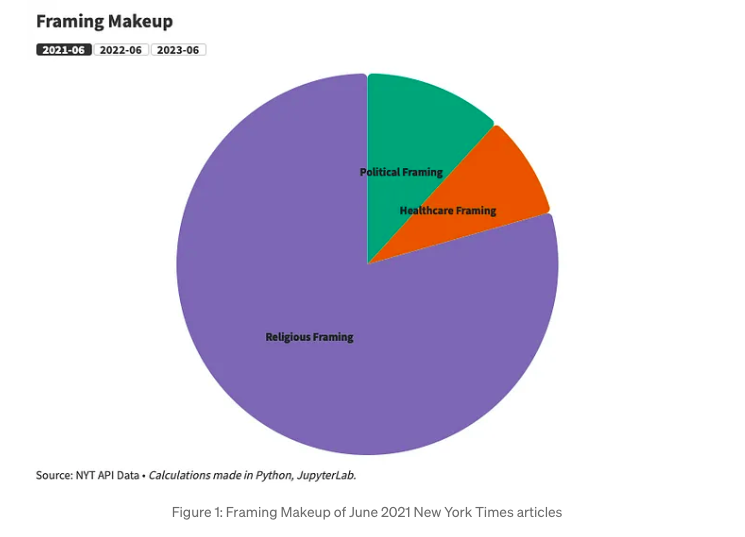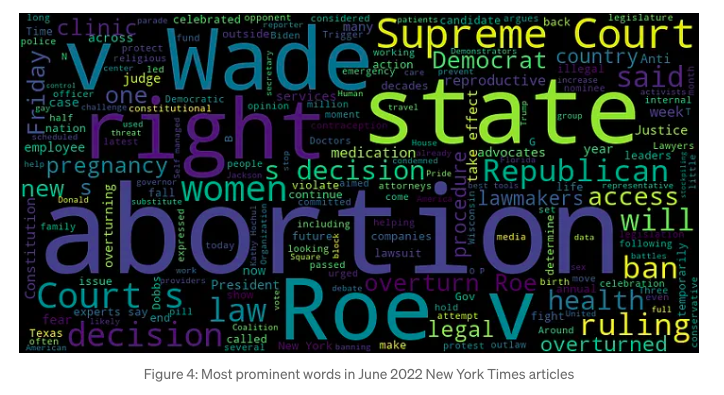Originally written for the University of Amsterdam and published on Medium.
With the 2024 general election less than a year away, it is more important than ever for voting Americans to remain educated and informed about various defining issues, such as abortion.
As more Americans have turned to social media platforms to receive news and information, there has been a consistently dropping level of trust in news organizations. In 2022, Pew Research found trust in national news organizations was 61% among American adults — down by around 15 percentage points from 2016.
Not only are Americans becoming concerned with what the press is reporting on, but also with how these issues are being presented. In order for trust to rise again — and for voters to make educated decisions — it is imperative to understand how news organizations frame defining issues.
I sought out to help provide some of this information, specifically looking at the New York Times (NYT) coverage of abortion. Abortion is expected to remain a highly debated topic in the months leading up to the 2024 elections. Politicians are likely to use their stance on the medical procedure as a campaign issue, and some states may continue to pursue legislative restrictions.
ABORTION COVERAGE BY THE NEW YORK TIMES
To establish what framing the NYT current uses when covering abortion, it is important to acknowledge how it may have changed in the last two years — particularly in the wake of the Supreme Court’s decision to overturn Roe v. Wade in June 2022.
Given this, I analyzed various of articles by text mining the NYT’s publicly accessible API from June 2021, June 2022, and June 2023. This data was collected through Python via JupyterLab, gathering articles featuring the word “abortion”.
While the initial collection was for 100 articles for each month, the text mining resulted in 67 from 2021, 100 from 2022 and 100 from 2023, resulting in 267 articles in total. This was not a complete surprise, given the greater relevance abortion had in the public sphere during the latter two years.
Overall, I found support evidence of three main frames the NYT uses when covering abortion:
Political
Healthcare
Religion
These frames can easily be observed through the specific wording used in various articles, which also illustrate a clear shift between 2021 and 2022 as seen in the word clouds below.
During June 2021, words such as “Catholic”, “bishops”, “church”, “communion” and “religious” were used quite frequently with heavy prominence, as seen in Figure 3.
This may be explained by U.S. Catholic Bishops seeking to bar politicians who identified as Catholic from receiving communion at the time — including President Joe Biden. One can argue that because of this, the religious framing is deeply intertwined politically, however for the purpose of this analysis, it is included as its own individual frame.
The analysis did find evidence of these three frames overlapping. However, a plurality of articles reviewed were categorized under just one. For example, articles collected in June 2022 carried a clear political framing, with words such as “Supreme Court”, “law’, and “ruling” having prominence.
There is also evidence of some articles holding more of a healthcare framing, including keywords such as “medication”, “health”, and “clinic.” These articles were the most likely to overlap with the two other frames when compared side by side.
While this analysis of collecting the most predominantly used words provides key insights into the NYT’s framing of abortion, I sought out to analyze this further to see how much of a difference there can be within the coverage.
After selecting five keywords representing each frame, we can easily see how the major outlet shifted its coverage dramatically.
Out of all the phrases searched for, “Supreme Court” was found the most, appearing a total of 27 unique times out of the 267 articles. This was followed by “ruling” and “laws,” which appeared 19 and 15 times respectively. Meanwhile, the word “doctor” was the least commonly found, only appearing twice between 2021 and 2023.
As seen below, the NYT appeared to impose more of a religious frame on its coverage of abortion in 2021, before drastically shifting gears politically a year later. While there was still a large emphasis on political framing in 2023, it was not as heavy as 2022. One could argue this is evidence of the outlet evening out its coverage, however, articles framed as healthcare or religious issues also continued to drop or stayed even.
Figure 5: Media framing in New York Times abortion coverage by keywords
CAN THIS CHANGE?
As abortion and women’s rights activists have spoken out against the excessive use of political framing, Erin Wager, the director of digital design and development communications for Planned Parenthood’s North Central States, explained it goes deeper than simple wording choices.
“That is by virtue of the landscape that we’re in,” Wager said.
“We’re fighting for basic healthcare in our legislatures and our courts and really, in almost every aspect of the landscape that we’re working in.”
The NYT has seemingly lessened its use of political framing (Figure 5), and Wager acknowledged there are some improvements. But to her, it’s still not enough.
“We are constantly still reminding people that abortion is healthcare, and the headlines don’t always reflect that.”
In order to veer away from political framing, Wager suggested journalists emphasize the personal stories from women who have undergone the procedure. The non-profit Reproductive Freedom For All (NAARL) has released similar recommendations, encouraging news organizations to include a variety of sources — namely medical and personal.
This shift in framing may take some time as Wager revealed she doesn’t believe there is currently any way to completely separate abortion coverage from political framing.
“I’m hopeful that we’ll get to a point, but not in our current landscape now.”




